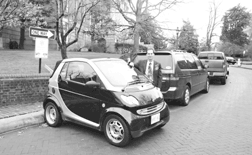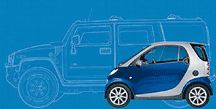Smart Car Turns Heads
Pint-sized auto runs on gasoline, diesel or biodiesel and gets 50 to 60 miles per gallon
by Carrie Madren, Bay Weekly staff writer
When Jon Cardin drives his 50-minute commute into Annapolis, people gawk. Truck drivers get photos of the vehicle next to theirs. Pedestrians point, stare and wave as he cruises by.
His attention-getting ride came in the form of a six-foot-long Smart Car, made by German-American automaker DaimlerChrysler and currently only sold in Europe.
“It is a blast to drive,” adds the fifth-year Baltimore County delegate.
The eight-foot-long car — not much bigger than a golf cart — has been Cardin’s ride since the first day of session.
He has to give it back this week to the Bosch Car Service, in Michigan, which leased him the car for $150 after a test drive at the National Conference of State Legislatures.
In Europe, some 750,000 of the vehicles have sold in 36 countries. Next year, the U.S. will become the 37th country to sell the auto. Then Americans, too, will maneuver into tight parking spots.
“I’ve never had a problem finding parking for the car. I went down to Federal Hill in Baltimore at 8pm on Saturday night — the hardest time to find parking anywhere in the city — and I just squeezed in between two cars. No problem,” says Cardin, who normally drives a Honda Insight, a hybrid.
The tiny car can run on either diesel or biodiesel, fuel derived from vegetable oils like soybean, or from waste vegetable oil, like the kind used to cook fast food and fries.
“It has the distinct aroma of fried foods when you fill it up with biodiesel,” says Cardin, who gets his biodiesel from a co-op in downtown Baltimore and a station in Carroll County.
He usually pumps three and a half gallons into the five-gallon tank, enough for 200-plus miles of driving.
The pint-sized auto gets between 50 and 60 miles per gallon, a little more when it burns diesel, a little less with biodiesel. That’s slightly less than his hybrid, which averages some 65 miles per gallon, he says.
“It’s roomy on the inside. It’s got more leg room than the Honda Civic or most coupes,” he says.
The two-seat car’s height allows for taller people. At five-foot-eight, Cardin has no problem sitting tall in the five-foot-high car that boasts a fold-back roof. Even a six-foot-four-inch friend caught a comfortable ride with Cardin.
Drawbacks include limited room for luggage. The small space behind the front seat might hold two pieces of medium luggage, Cardin estimates. The 1,600-pound car also feels somewhat unsteady in high winds.
Still, he’ll buy one if he can afford it: Cardin fears that 2008 models will cost $25,000 to $30,000 — two and a half times what it’s sold for in Europe, he says. Smart Car’s website offers a more reassuring price, predicting that new Smart Cars will cost “under $15,000” in the U.S. An electric version will sell for $35,000.
The zippy car has traveled slowly to America because of government safety and emissions regulations. Emissions from the tailpipe were so low that they couldn’t be calculated by our pollution-measuring instruments, Cardin says.
American Smart Cars — slightly bigger than the European model — will measure at nearly nine feet and have more safety equipment.
But the small advantages will remain.
“Bigger isn’t always better,” says Cardin, who says he drives the Smart Car to “send a message to people that there are ways to be an environmental steward and also be able to get to where you need to. It’s not a reduction of convenience or taking away of luxury.”
Parking more easily and negotiating city traffic would be easier, he thinks, if more people drove these cars.
“For people who are city drivers or commuters,” says Cardin, “it is a very common-sense transportation.”
